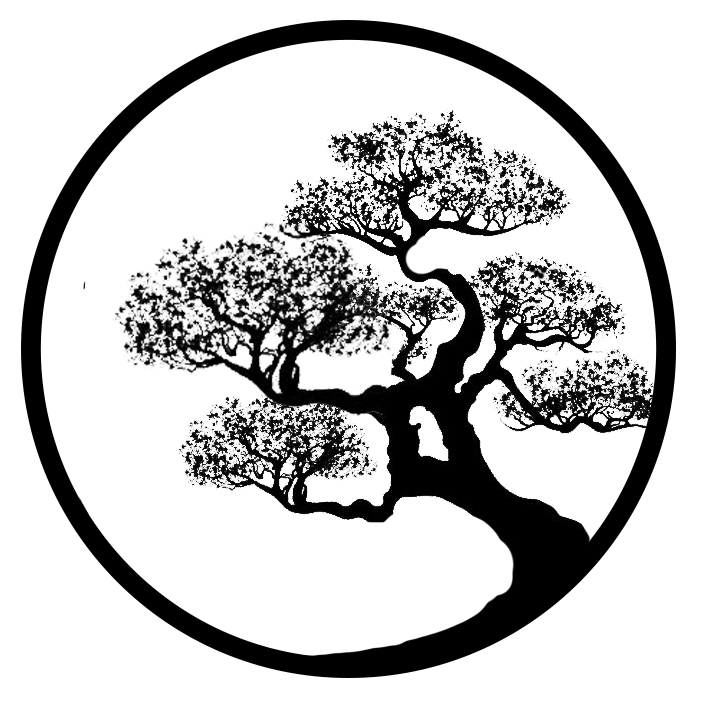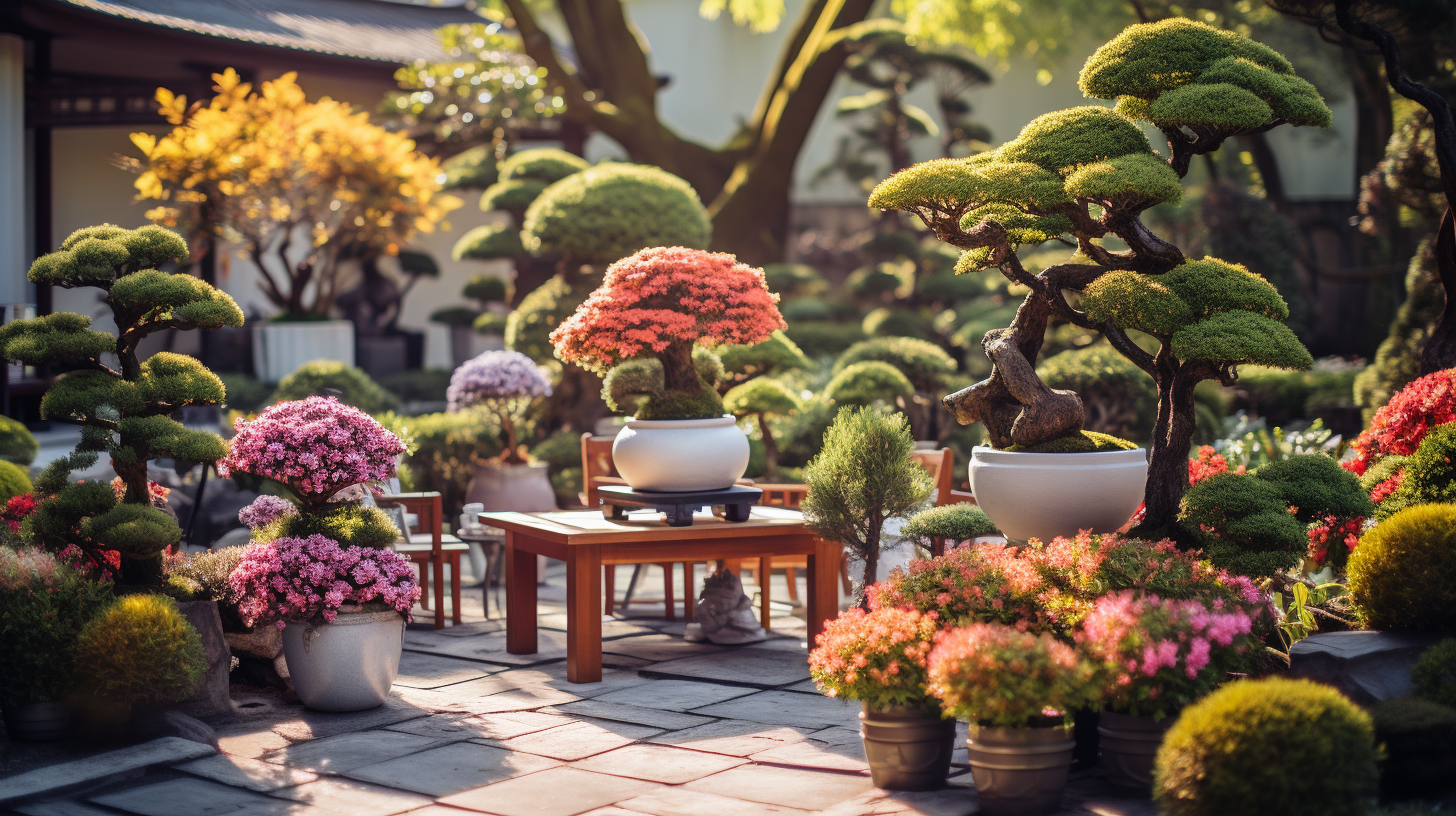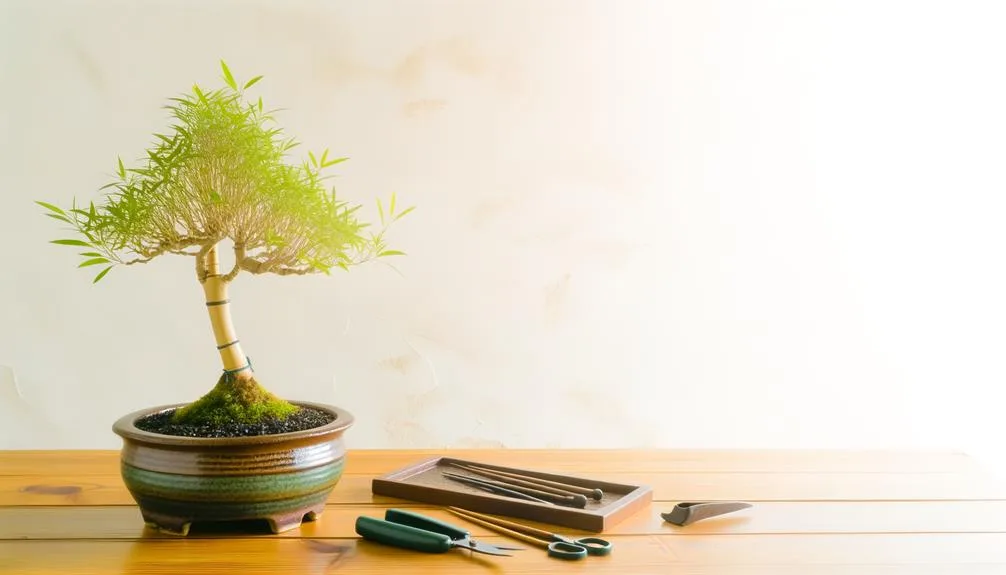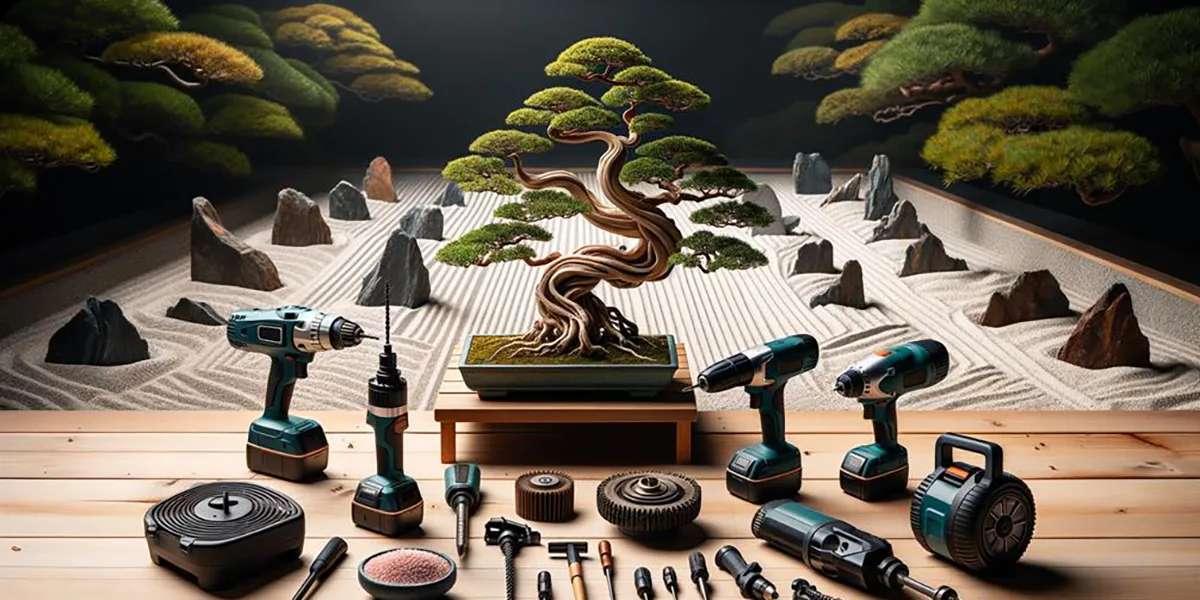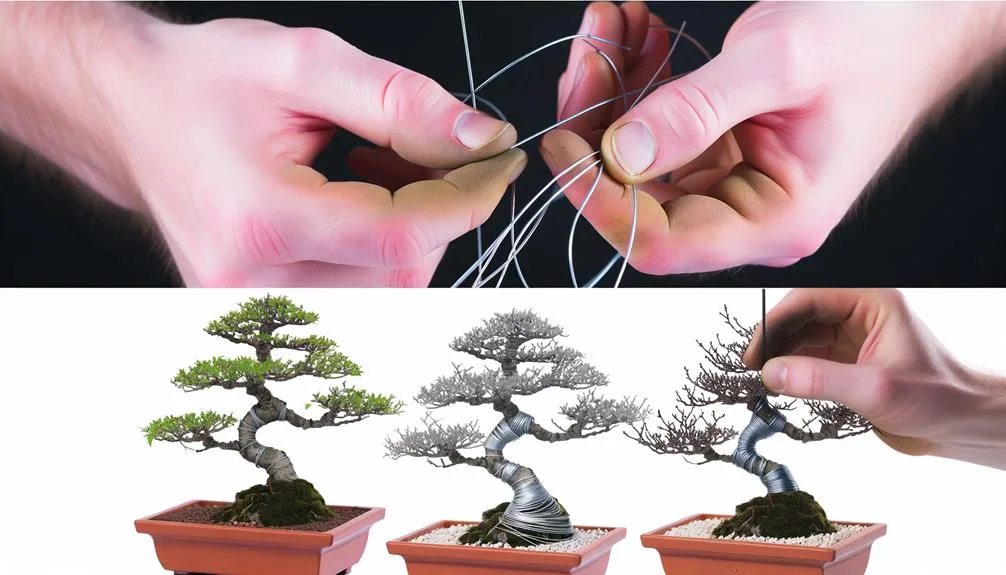Introducing the top 7 Best traditional Japanese bonsai variations from the splendid world of bonsai.
Ranging from the well-known, foliage-rich Pines to the delicate Japanese Maple, known for its seasonal color changes, these variations offer a diverse array of styles and shapes for your selection.
Let’s begin our journey of learning and broaden our understanding of these stunning bonsai variations.
Key Takeaways
- Pine bonsai are evergreen trees renowned for their symbolic value and aesthetic appeal. Popular varieties are the Japanese Black Pine and Japanese White Pine. They require abundant sunlight, well-drained soil, regular pruning, and protection from extreme cold.
- Cherry blossom bonsai are admired for their delicate pink blooms that bloom in spring. They add elegance and represent renewal. Care includes proper sunlight, watering, fertilizing, pruning, and protection from temperature extremes.
- Japanese black pine is appreciated for its bold, twisted shape and hardy nature. It allows diverse styling options like formal upright and cascade forms.
- The Japanese white pine is distinguished by its fine needles and graceful branching pattern. Deadwood techniques enhance its visual interest. It needs plenty of sun and proper watering.
- Japanese red maple offers vibrant red, orange and yellow foliage. Its small size makes it ideal for bonsai. It can withstand cold climates.
- Japanese cedar is valued for its abundant green foliage, slender trunk and sweeping branches. It retains its leaves year-round and requires relatively low maintenance.
- Japanese quince produces stunning pink, red and white blossoms in spring. It thrives in well-drained soil and with adequate sunlight and water. Pruning helps maintain its shape.
In summary, traditional Japanese bonsai encompass a diverse range of tree varieties, each with unique aesthetic qualities, care needs and significance in bonsai culture. Exploring the variations allows deeper appreciation of this living art form.
Pine
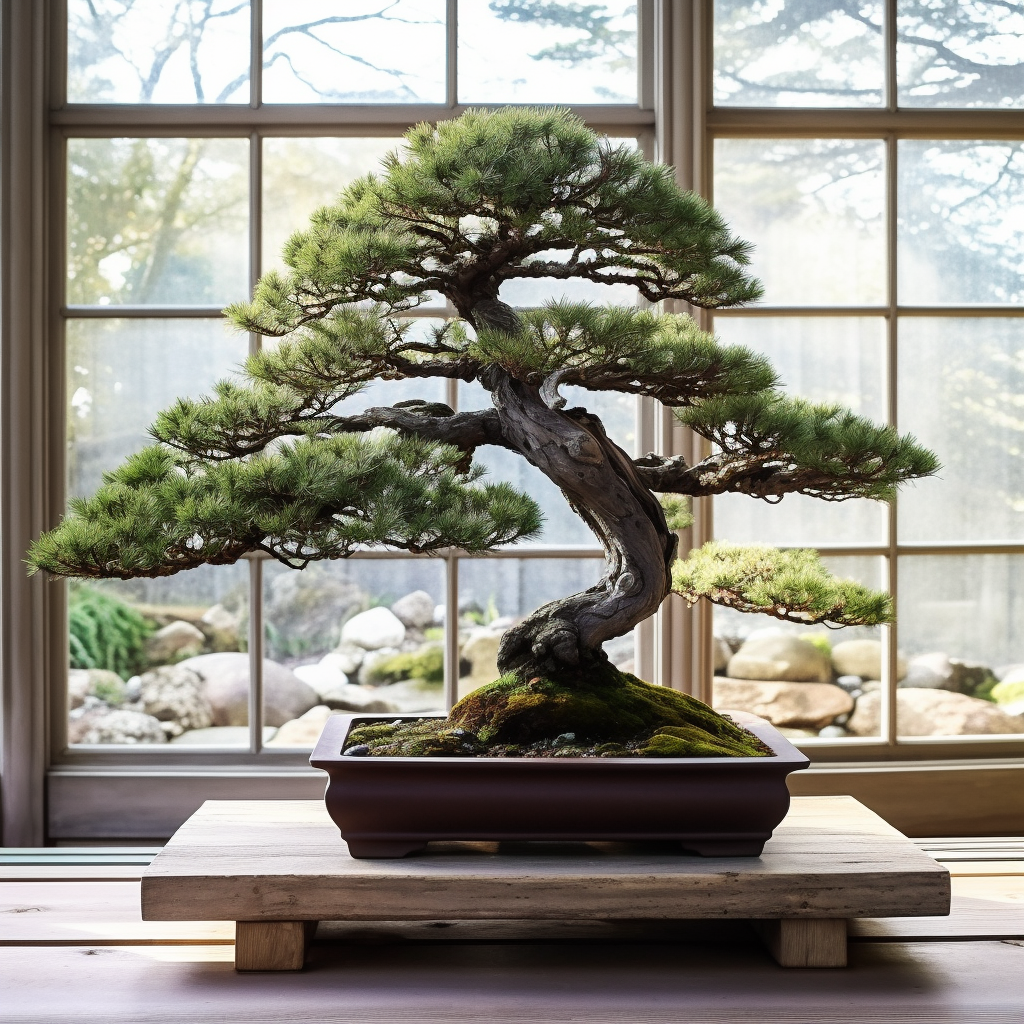
Pine trees, hailing from the Pinus family, hold a distinct place in the world of traditional Japanese bonsai. Their alluring aesthetics and symbolic value make them highly admired. The evergreen nature of these trees provides a green oasis of calm and serenity all year round. Pine variants are adaptable to several forms, such as the formal upright, informal upright, and the cascade, which adds to their versatility.
Two species stand out for their suitability in the bonsai world, namely the Japanese Black Pine (Pinus thunbergii) and the Japanese White Pine (Pinus parviflora). These species are preferred for their small needle size and dense foliage, which are highly conducive for bonsai designs.
For a Pine bonsai to flourish, it requires regular trimming to preserve its form and denseness. It also thrives best in soil that drains well and under abundant sunlight. Known for their resilient nature and timeless appeal, Pine bonsai are truly a work of art in the bonsai world.
As an old bonsai saying goes, ‘The bonsai isn’t you working on the tree; you have to feel the tree working on you.’ This saying perfectly encapsulates the joy and satisfaction derived from nurturing a Pine bonsai.
Care Tips for Pine Bonsai
- Sunlight: Pine bonsai trees thrive best under abundant sunlight. Ensure that your Pine bonsai is placed in a location where it can receive at least five to six hours of direct sunlight daily.
- Watering: Watering should be done judiciously. The Pine bonsai prefers to remain slightly dry rather than overly watered. Excessive watering can lead to root rot. It is best to water the tree thoroughly, then wait for the soil to become slightly dry before watering again.
- Soil: A well-drained soil is preferable for Pine bonsai. Consider using a bonsai soil mix that contains lava rock and pine bark as this ensures good drainage and aeration for the roots.
- Pruning: Regular pruning is crucial to maintain the Pine bonsai’s shape and to promote denser foliage. Pruning should be done carefully to avoid damaging the tree. It is best to prune new growth back to two or three buds during the growing season.
- Fertilizing: Apply a balanced bonsai fertilizer during the growing season to encourage robust growth. However, reduce fertilization during the winter months when the tree’s growth is dormant.
- Repotting: Pine bonsai need to be repotted every two to five years, depending on the tree’s age and the size of the pot. This is necessary to replenish the soil’s nutrients and to prevent the roots from becoming pot-bound.
- Protection: While Pine bonsai are generally resilient, they do need protection from extreme weather conditions. In winter, provide some protection against freezing temperatures, especially for young trees.
Remember, taking care of a Pine bonsai is a labor of love and patience. Each tree has its own unique requirements, so be attentive and responsive to the needs of your bonsai.
Cherry Blossom

Cherry Blossom Bonsai Trees: A Touch of Elegance and Serenity
Bonsai enthusiasts often adore the delicate pink flowers of the Cherry Blossom bonsai trees. These ornamental trees offer an exquisite blend of charm and elegance, making them a popular pick among bonsai lovers.
Here are five compelling reasons to add a cherry blossom bonsai tree to your collection:
Floral Display: The vivid pink blooms of these trees are a visual treat, symbolizing the onset of spring.
Cultural Importance: Rooted deeply in Japanese tradition, cherry blossoms signify renewal, beauty, and the impermanence of life.
Creative Pruning: The pruning and shaping of a cherry blossom bonsai tree’s branches present opportunities for artistic expression and the development of unique forms.
Seasonal Transformation: Appreciate the changes of the bonsai with each passing season, from the eruption of blossoms in spring to the leaf color changes in fall.
Tranquil Atmosphere: The sight of a cherry blossom bonsai tree at its peak bloom can induce feelings of tranquility, adding a peaceful vibe to any setting.
Adding a cherry blossom bonsai tree to your collection can undoubtedly enrich its beauty and offer a rewarding experience in your bonsai journey.
‘Growing a cherry blossom bonsai tree isn’t just about nurturing a plant; it’s about cultivating an art form that brings serenity and beauty into your life.’
Blooming Characteristics Of The Cherry Blossom
Blooming characteristics involve the specific features and behaviors that a plant exhibits during its flowering period. These characteristics include the timing of bloom, the duration of bloom, the color and shape of the flowers, the number of flowers produced, and the plant’s pollination mechanisms.
Timing of Bloom: Some plants bloom in the spring, others in the summer or fall. Depending on the species, flowering could occur at any time of the year. Some plants, known as “day-neutral,” bloom regardless of the length of daylight hours. Others, known as “short-day” or “long-day” plants, only bloom when the day length is either shorter or longer than a certain amount of time.
Duration of Bloom: Cherry blossom bonsai trees have a relatively short blooming period. They usually bloom in the spring, with the flowering period lasting for about one to two weeks. However, the exact timing and duration may vary depending on the specific variety and local climate conditions.
Number of Flowers: Some plants produce only a single flower, while others produce hundreds or even thousands. The number of flowers can depend on factors such as the plant’s age, size, health, and environmental conditions.
Color of Flowers: They are best known for their pale pink to white blossoms that bloom from crimson buds before the leaves appear.
Pollination Mechanisms: Many plants rely on insects, birds, bats, wind, or water to transfer pollen from the male parts of a flower to the female parts. Get a small brush and when new flowers start, take the brush and go over one flower then go and brush over another flower.
Understanding a plant’s blooming characteristics can help gardeners and landscapers choose the right plants for their needs and preferences, and can help scientists study and conserve plant biodiversity.
Care Tips For Cherry Blossom Bonsai Trees
- Sunlight: Cherry Blossom bonsai trees require full sun exposure for at least four to six hours each day. An ideal spot is one that gets morning sun and afternoon shade.
- Watering: Regularly water your bonsai tree, but make sure it is not overly saturated. The soil should be kept moderately moist. During hot weather, you might need to water your tree daily.
- Feeding: Feed your cherry blossom bonsai with a balanced fertilizer every two weeks during the growing season and once a month during the winter.
- Pruning: Regular pruning encourages the tree to maintain its miniature size and promotes the growth of new buds. It’s best to prune in late winter or early spring before the onset of the new growth.
- Repotting: Repot your cherry blossom bonsai every two to three years. Spring is the best time to do this, just before the tree starts to bud.
- Soil: Use a well-draining soil mix that is rich in organic matter. A combination of loam, peat moss, and sand or perlite makes a good soil mix for cherry blossom bonsai trees.
- Protection from Extremes: Protect your tree from extreme weather conditions such as excessive heat or frost. In colder climates, consider bringing your tree indoors during winter months.
- Disease and Pest Control: Watch out for common bonsai pests like aphids and scale insects. Regularly check the health of your tree and treat any diseases or pests as soon as they appear.
Remember, caring for a cherry blossom bonsai tree requires time and patience, but the reward is a beautifully blossoming tree that adds grace and serenity to your surroundings.
Japanese Black Pine

The traditional art of bonsai is deeply rooted in Japanese culture, and one notable tree that stands out in this practice is the Japanese Black Pine. Known as Kuromatsu locally, it’s a well-respected choice for bonsai enthusiasts owing to its distinctive aesthetics and robust nature. The dark green, needle-shaped leaves and gnarled, twisted trunk give the Japanese Black Pine a bold and commanding aura.
This bonsai tree allows for a wide range of styling options, from the formal upright style to the dramatic cascade form. The world of horticulture holds this tree in high esteem due to its hardiness and adaptability. Whether you’re a novice or an adept bonsai cultivator, the Japanese Black Pine could be an ideal addition to your collection.
Given the right care and pruning, this bonsai tree can flourish for years, bringing a sense of refinement and charm to your bonsai assortment. As a famous Japanese proverb goes, ‘The pine remains green in winter’s snow because it’s the tree of the gods.’ The same could be said about the resilience and timeless beauty of the Japanese Black Pine.
Japanese White Pine

The charm of growing a bonsai tree like the Japanese White Pine lies in the diligence it demands and the delicate beauty it returns. This bonsai variety is revered for its sophisticated and suave look.
Here are a few fundamental aspects to keep in mind while nurturing a Japanese White Pine bonsai:
- The Japanese White Pine (Pinus parviflora) is a favorite amongst bonsai hobbyists, owing to its exquisite, fine needles and a unique branching pattern that sets it apart.
- This variety flourishes in sunny environments and soil with good drainage, making it a good fit for outdoor growth.
- To keep the bonsai tree in the desired form and size, regular pruning and wiring are key.
- Deadwood bonsai techniques such as jin (stripped bark) and shari (carved deadwood), add to the visual appeal of the Japanese White Pine bonsai.
- A well-watered and suitably fertilized bonsai tree ensures its health and vigor.
Heed these guidelines and you’ll be rewarded with a spectacular Japanese White Pine bonsai, a testament to the serene beauty of traditional Japanese bonsai art.
As the saying goes, ‘Bonsai is a journey, not a destination.’ The joy lies in the process, in the day-to-day nurturing, in the quiet moments spent with your tree. And the Japanese White Pine makes for one captivating journey.
Japanese Red Maple

Moving forward in the journey of understanding traditional Japanese bonsai variations, the Japanese Red Maple is a notable standout. This bonsai species is renowned for its vibrant leaves and mesmerizing hues.
The Japanese Red Maple (Acer palmatum), with its fiery red, orange, and yellow leaves, is a bonsai tree that garners much attention. The small size and fragile branches of this species are ideal for bonsai cultivation as they can be easily manipulated and wired to achieve the desired visual appeal. Its ability to withstand freezing temperatures contributes to its robust nature, making it a preferred choice for bonsai lovers living in temperate climates.
A well-cared-for Japanese Red Maple bonsai tree can flourish and add a touch of natural beauty to any environment. In the words of an anonymous bonsai enthusiast, ‘Caring for a bonsai tree, especially a robust variety like the Japanese Red Maple, is like nurturing a living piece of art.’
Japanese Cedar

The Japanese Cedar, or Cryptomeria as it’s also known, is a popular choice among bonsai enthusiasts. This majestic coniferous tree holds a special place in Japanese tradition and is admired for its grace and symbolism. Here are some key features to consider when cultivating a Japanese Cedar bonsai:
- Plentiful Greenery: The Japanese Cedar is known for its rich, green foliage. The leaves form thick layers, creating a visually appealing effect.
- Elegant Structure: The slender trunk, coupled with the sweeping branches, lends the tree an elegant and delicate look.
- Aging with Grace: As the tree matures, the bark turns a reddish-brown color. This brings a certain depth and character to the bonsai.
- Beauty Throughout the Year: Unlike some trees, Japanese Cedars retain their leaves throughout the year, ensuring your bonsai stays attractive in all seasons.
- Manageable Care: As long as they’re correctly cared for, Japanese Cedars require relatively minimal maintenance. This makes them a good choice for both bonsai novices and those with more experience.
In essence, if you’re keen on cultivating a bonsai tree that radiates elegance and grace, the Japanese Cedar is a sterling choice to consider. As a bonsai enthusiast, remember, ‘The Japanese Cedar isn’t just a tree; it’s a living piece of art.’
Japanese Quince

Let’s delve into the world of the traditional bonsai variant, the Japanese Quince. Known in botanical circles as Chaenomeles japonica, this deciduous shrub is celebrated for its stunning springtime display of pink, red, and white blossoms.
To ensure that your Japanese Quince bonsai thrives, it requires a few specific care requirements. These include a well-draining soil environment, consistent watering, and plenty of sunlight exposure. During its dormant period, thoughtful pruning and shaping of the branches are beneficial for maintaining its aesthetic form and encouraging vigorous growth.
‘Japanese Quince bonsai isn’t just a plant; it’s a living artwork that changes with the seasons, bringing joy and serenity to any space’
Hiroshi Takeuchi
Blooming Characteristics of Quince
The Alluring Qualities of Quince Blossoms
When you start learning about the blooming qualities of the Quince (Japanese Quince), you’ll notice its lustrous and engaging flowers.
- Quince flowers are famous for their rich hues, which span from bright reds to soft pinks and whites.
- These blossoms are usually big and flamboyant, injecting a splash of color into any garden or bonsai arrangement.
- Quince flowers typically make their appearance in early spring, forming a gorgeous contrast against the bare branches of the tree.
- The scent of the Quince flowers is another significant feature, permeating the air with a sweet and pleasing aroma.
- The blossoming features of Quince make it a favorite among fans of ornamental plants and gardening aficionados.
Care Tips for Quince
Nourishing Your Quince Bonsai: A Comprehensive Guide
For the enthusiasts of the beautiful Japanese Quince bonsai, providing the right care is integral to maintain its vitality. Let’s focus on five key areas: sunlight exposure, watering, fertilizing, pruning, and repotting.
First, exposure to sunlight is fundamental. Position your quince bonsai where it can bask in at least six hours of daily sunlight. These bonsais flourish in a mix of full sun and partial shade.
Watering comes next in line. Quince bonsai prefers its soil to be consistently moist but not oversaturated. Aim for thorough watering sessions, allowing the soil to dry a bit before the next one.
Next, let’s talk about fertilizing. You need to feed your quince bonsai during its growing season with a balanced bonsai fertilizer. This nourishment is important for its healthy growth.
Pruning is a practice that helps maintain the shape and size you desire for your bonsai. Regular pruning helps to control growth and retain the aesthetic appeal of your bonsai.
Finally, repotting your Quince bonsai every 2-3 years helps to replenish the soil and encourages healthy root development.
By paying attention to these five critical aspects of care, you nurture your quince bonsai in a way that ensures its growth and beauty.
It’s like the famous botanist, Luther Burbank, said, ‘Flowers always make people better, happier, and more helpful; they’re sunshine, food, and medicine for the soul.’ Let your quince bonsai be that source of joy in your home or garden.
